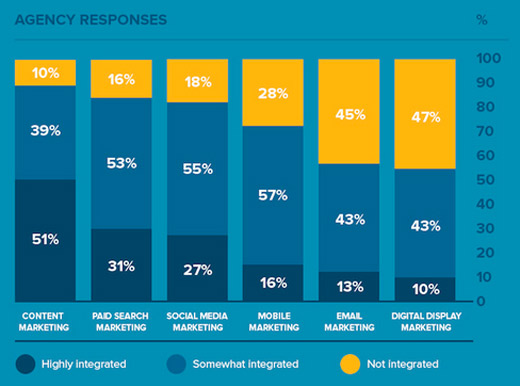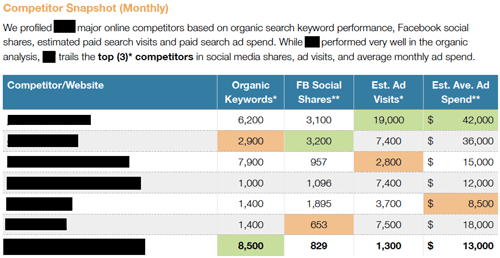When it comes to better keyword rankings and improved search engine performance, one of the most difficult concepts for folks to wrap their heads around is the competitive landscape. No business lives in a vacuum. If you just can’t seem to make it past position #6 in Google, the problem may not be your agency or even your strategy.
Know Where You Stand
Most business owners know where they rank for a given keyword, but they don’t know why. If you ask a company where they show up on Google for keyword X, if they don’t know they will Google it to find out. This is where the problem exists. Many business owners don’t have any idea what it takes to get from position #7 to position #1 or even position #3. Often, business owners will assume “Hey, it’s only 6 spots! How hard could it be?”. In reality, it can be costly and take several months.
“No business lives in a vacuum.”
Not having a clear understanding of the search engine landscape and how your competitors fit into that landscape can be frustrating to a small business owner. SEO and digital marketing goes way beyond what most companies track or see on a daily basis. Take Dr Pete’s Moz slides for example:
The slides above show just how complex and challenging it can be to get a handle on where your company stands. While you may be doing very well for keyword X, there are several other ways people can find your website on search engines, not to mention all the social media websites, and advertising platforms. How does your business get a clear picture of where it stands? The answer may be a hybrid competitive analysis.
The Hybrid Digital Marketing Competitive Analysis
Since social media and SEO have become much more integrated (see chart below), there is a need to track both organic search and social media together.

With Google indexing more tweets on Twitter, even more so. The strong correlation between social media activity and organic performance is not by chance. Some may argue that social media shares do not equal great organic rankings. Part of this may be true. What social media does is amplify content. Getting good content in front of someone who may run a website or media outlet is key. Content discovery is important if you’re ever going to get your content linked from an online article or a blog post. If you have great content, you’ll get lost of shares from influential sources. If it’s not great content, it may get very few shares, which will result in fewer incoming links.

Seen above, we used this simple competitive analysis report when presenting to a client. Some of the major factors we outlined were Facebook social media shares, total keyword depth, estimated paid advertising visits, and paid advertising monthly spend. From a few independent tools, we were able to combine data sources into a simple summary report. From the report, we were able to highlight strengths and weaknesses. We noticed a strong organic search footprint, so maybe that area was ok for now. The other areas, social media and paid search, were further behind the competition.
“On the surface, all appeared good.”
On the surface, all appeared good. The client was doing well for their keyword X’s. So you would think that company is dominating the market, right? If you dig deeper, you can see why they may be losing market share to competitors in the last couple years. The client knew there was a problem, they just didn’t know what.
5 Benefits of a Competitive Analysis
There are several reasons why you should do a basic competitive analysis once or twice a year. Below are just a few.
1. Make a Business Case to Increase Spending
If you’re trying to get more budget for your campaigns, a competitive analysis is the way to go. Are sales down? Are you paying more for the same customers? Whatever the case may be, having competitive research at your disposal is the first step to convincing your CEO that you need more funding. If you’re in-line with competitors, this may be less of a factor. If your competition is spending five times your budget, they may be gaining market share at a rate that can kill your business over time.
2. Identifying Easy Wins
With a deep dive competitive report, you’ve identified the easy wins or “low hanging fruit”. You now know that starting a Google Shopping campaign is probably a good idea if all your top three competitors run campaigns. Or, getting some kind of basic Facebook advertising campaign running is a good idea if your competitors are gaining shares at a high rate each month.
3. Close the Gaps!
If you notice specific gaps in tactics across several competitors, that may be a clue as to why your performance has lagged. You don’t want to chase everything competitors are doing, but if you see a few industry leaders all doing the same tactic and seeing success, it may be time to jump in. Worse than being last is not even starting the race. You can’t catch a dominant competitor overnight, but you should have a strategy to chip away at their market share.

4. “Smithers, release the hounds!”
If you noticed a competitor entrenching on your advertising space or keywords, take note. Find out what they’re doing. Learn from what they’re doing well. Keep tabs on changes to their program. Increases in the budget during specific timeframes? Hmm. You may see competitors begin to copy your tactics. It’s frustrating to see, but may be a sign you’re headed in the right direction.
5. Staying Current
If you’re always tracking what your competitors do in the space, you’re a student of the industry. You will learn valuable new tactics and strategies that will help you grow. If you stick with the status quo or give up, things may be good for a little while. Eventually, you will fall behind smaller competitors that are more agile and willing to take risks.
I hope these tips will help you build your own competitive strategy. Good luck! If you find this article useful, please share on Twitter, Facebook, Linkedin, or Google+.
